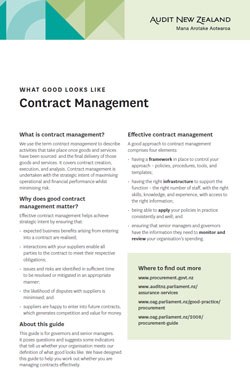Contract management
This is part of our series on What good looks like, produced by our Specialist Audit and Assurance Services team.
What is contract management?
We use the term contract management to describe activities that take place once goods and services have been sourced and the final delivery of those goods and services. It covers contract creation, execution, and analysis. Contract management is undertaken with the strategic intent of maximising operational and financial performance whilst minimising risk.
Why does good contract management matter?
Effective contract management helps achieve strategic intent by ensuring that:
- expected business benefits arising from entering into a contract are realised;
- interactions with your suppliers enable all parties to the contract to meet their respective obligations;
- issues and risks are identified in sufficient time to be resolved or mitigated in an appropriate manner;
- the likelihood of disputes with suppliers is minimised; and
- suppliers are happy to enter into future contracts, which generates competition and value for money.
About this guide
This guide is for governors and senior managers. It poses questions and suggests some indicators that tell us whether your organisation meets our definition of what good looks like. We have designed this guide to help you work out whether you are managing contracts effectively.
Effective contract management
A good approach to contract management comprises four elements:
- having a framework in place to control your approach – policies, procedures, tools, and templates;
- having the right infrastructure to support the function – the right number of staff, with the right skills, knowledge, and experience, with access to the right information;
- being able to apply your policies in practice consistently and well; and
- ensuring that senior managers and governors have the information they need to monitor and review your organisation’s spending.
Where to find out more
- New Zealand Government Procurement website, www.procurement.govt.nz
- Good practice guides on the Office of the Auditor-General's website, www.oag.parliament.nz/good-practice
| 10 questions | Indicators of what good looks like | |
|---|---|---|
| Framework | 1. Do you take a strategic approach to managing your suppliers? |
|
| 2. Are your policy, procedures, and guidance up to date and reflect good practice. |
|
|
| Infrastructure | 3. Have you got the right number of staff, with the necessary expertise, and in the right structure? |
|
| 4. Do you have a contract or supplier relationship management system? |
|
|
| Application | 5. Is planning done to ensure a smooth start to, or transition between contracts? |
|
| 6. Do you have a robust approach to contract financial control? |
|
|
| 7. Do you have a robust approach for monitoring supplier performance? |
|
|
| 8. Is there a structured approach when contracts are completed? |
|
|
| Monitor and review | 9. Do you review your approach? What have you learnt? |
|
| 10. Are governors informed enough to assess whether contracts are being effectively managed? |
|
|
Page created: 4 June 2021

